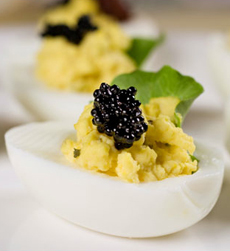RECIPE: Deviled Eggs For New Year’s Eve
|
Why do deviled eggs endure as a party favorite? Of all the retro hors d’oeuvre—including stuffed celery and rumaki, a skewered chicken liver and water chestnut invented by “Trader Vic” Bergeron—deviled eggs keep holding their own. Even people who rarely, if ever, eat a boiled egg can’t help plucking a stuffed egg off the tray. And speaking of trays: how many other hors d’oeuvre have specially designed trays? There are even carrying trays, to help you safely transport your eggs to the party; and Spode porcelain trays shaped like Christmas trees and a Lenox butterfly stuffed egg platter. So join the stuffed egg lovers parade, and make a recipe for New year’s Eve:
|
A party favorite with many recipe variations. |
|
|
Here’s a tip from Andrea Watman, catering manager at Zabar’s in New York City, to boil the perfect egg: The day before I am going to hard boil the eggs, I turn the carton on its side. First, make sure the carton is closed securely and second, be careful because eggs are more likely to crack on their side. (It has to do with Mother Nature protecting the eggs: The shells are harder vertically to protect them when they are laid). Then, place the eggs in a sauce pan and cover with cold water and add one tablespoon of salt. Bring water to a full boil, turn heat down and boil for one minute. Turn off heat and allow eggs to stay in pan for 15 minutes. Rinse eggs in cold water for 5 minutes. Peel the eggs under cold running water. There’s a key difference between “stuffed eggs” and “deviled eggs.” Deviled eggs refer to the use of hot spices or condiments in a recipe—paprika, mustard, hot sauce, horseradish, chiles, etc. The concept originated in 18th-century England.
|
||



